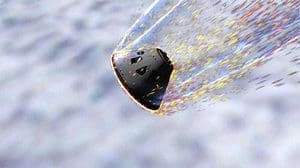Last year NASA permanently retired the iconic shuttle program, since it became obsolete, too expensive, difficult to maintain and no longer resonated with the agency’s goals. Its successor is no other than the Orion capsule, a spacecraft capable of deep-space exploration missions developed by Lockheed Martin in collaboration with NASA. So far, it’s more or less complete, with its first unmanned test run scheduled for 2014, however the manned flight has been pushed back to 2021, after initially it was supposed to launch only two years after the first test. Meanwhile, NASA is renting Soyuz launches from Russia for at least $50 mil. a piece, and although private space flight carry some of NASA’s loads into space, it still seems like that shuttle could’ve still come in handy.
The Orion spacecraft is one of the most ambitious aerospace projects in the world at the moment. When completed, it should be able to carry man safely to missions in deep-space, asteroids and even Mars. However, there are a lot of variables to consider and for this multi-billion dollar project, there is absolutely no room for error. The first test, scheduled for 2014, is meant to demonstrate that its design can handle the harsh Earth re-entry conditions, where temperatures of over 4,000 degrees are expected.Pacific landing mock-up tests have been so far excellent.
“The entry part of the test will produce data needed to develop a spacecraft capable of surviving speeds greater than 20,000 mph and safely return astronauts from beyond Earth orbit,” Associate Administrator for Human Exploration and Operations William Gerstenmaier said in a press release. “This test is very important to the detailed design process in terms of the data we expect to receive.”
The 2021 manned push back announcement, however, comes as a huge disappointment, and most likely is intended to sync with with the testing schedule for the Space Launch System, an advanced rocket launch system which will allow Orion head on trip to an asteroid in 2025 and a journey to Mars around 2030, but even these dates might likely suffer modification – the optimist in me hopes for an earlier advance.
“President Obama and Congress have laid out an ambitious space exploration plan, and NASA is moving out quickly to implement it,” NASA Associate Administrator for Communications David Weaver said. “This flight test will provide invaluable data to support the deep space exploration missions this nation is embarking upon.”
What about the up and going administrations to follow? Will they see space flight as man’s prime path towards evolution or decide to divert funds towards the military? The optimist in me.










